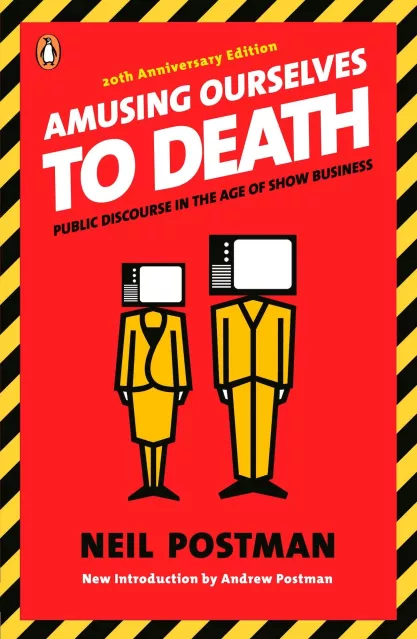Table of Contents
Are we ‘Amusing Ourselves to Death’ in 2023?

Shutterstock.com
We often talk about discourse in terms of whether specific ideas should be “platformed” — in college lecture halls, entertainment venues, or on social media timelines.
But if Neil Postman, media critic and author of “Amusing Ourselves to Death: Public Discourse in the Age of Show Business,” were alive today, he might argue that those who believe speech they dislike represents the ultimate danger to public discourse are missing the forest for the trees. We should be most concerned not about the existence of a particular hot take on today’s most heated topics, but the insidious ways our modes of communication degrade the quality of our speech and thought.
In 1985, he was talking about television. In 2023, his critique can be applied to social media.
Comfortably numb
“Amusing Ourselves to Death” opens by examining the dynamic duo of dystopian fiction: George Orwell’s “1984” and Aldous Huxley’s “Brave New World.”
Postman argues that Orwell’s vision of a dystopian society controlled top-down by a repressive central government is less conceivable than Huxley’s, wherein people numb themselves into submission by consuming an endless stream of trivial entertainment.

He posits that in a media landscape dominated by thematically and tonally incongruous fragments of information, censorship — long the favorite weapon of authoritarians of all stripes — may not even be necessary for imposing social control. People uninterested in serious matters, placated into inaction by an overwhelming barrage of distracting entertainment, will lack the proper contextual awareness and requisite depth of insight to recognize tyranny, let alone combat it.
While censorship remains a powerful and frequently wielded force today, Postman was right to recognize that it’s not the only threat to a productive public conversation. We need only glance at accounts of social media platforms amplifying polarization and division and shortening attention spans — or Twitter’s “trending” section — to tell us that.
“Every technology has an inherent bias,” wrote Postman. “It has within its physical form a predisposition toward being used in certain ways and not others.”
The medium of typography, he claimed, encourages “mature discourse”: “a sophisticated ability to think conceptually, deductively and sequentially; a high valuation of reason and order; an abhorrence of contradiction; a large capacity for detachment and objectivity; and a tolerance for delayed response.” By “typography,” Postman was likely speaking, specifically, of long-form writing.
Television, on the other hand, lacks the thematic cohesion and sequential structure of a book, newspaper, or essay. In Postman’s view, with its image-centric focus, short, discrete segments punctuated by ad breaks, and tonally inappropriate music, this medium trivializes information by turning it into entertainment masquerading as serious discourse, conveying “Dadaism,” “nihilism,” and “schizophrenia.”
Talking across different realities
If we turn a Postmanian lens on today’s dominant forms of communication, we discover similarly disjointed experiences in our personalized news feeds. However, the current landscape is even more disorienting than one dominated by television, as no single medium reigns supreme in informing social norms beyond the screen.
On Twitter, for example, the coin of the realm may not be mere entertainment, but outrage conveyed by pithy blurbs of text. On Instagram, the appearance of authenticity through expertly staged photographs. On TikTok, novelty via mesmerizing video clips.
While the attitudes, assumptions, and styles of interaction we adopt offline may depend on which online platforms we spend the most time with individually, we all have reason to believe that other peoples’ basic framework for interpreting reality is jarringly different from our own.
Reading “Amusing Ourselves to Death” in 2023 is a clarifying reminder that a healthy culture, like a fruitful garden, needs cultivating. This means examining not only content, but also context. It means digging below the surface of our conversations, tending to the roots that lie beneath.
Jonathan Haidt’s “Tower of Babel” metaphor is relevant here. Funneled into various algorithmically personalized niches, or spending time in vastly different media environments, it’s as if people speak different languages. Lacking a shared foundation from which to communicate clearly with one another, speech is undermined before it can fulfill its loftiest purpose: exposing bad ideas and giving rise to better ones, enabling people to make sense of reality by approaching deeper conceptions of truth, knowledge, beauty, purpose, meaning, or value.
Instead of deepening discourse across difference, the overarching message of our present reality is simple: Stay in your rabbit hole. Let us entertain you.
“Dadaism,” “nihilism,” “schizophrenia”: The words Postman used to describe the spirit of the culture in 1985 might, in today’s parlance, be updated to “incoherence,” “cynicism,” “dissociation.” If this is the case 38 years after “Amusing Ourselves to Death” was published, what’s to be done? Is there any greater hope now of facilitating productive conversations than there was then?
The future is hazy, but not all signs spell doom and gloom.
The promise of new media
Arguably, some fragments within our media landscape invite meaningful interaction — and some of these fragments are so large, the term “fragment” may be too dismissive.
Podcasts, for example, rarely reflect the disorienting experience of social media sites, as episodes frequently spend hours — not minutes — exploring a few interrelated topics, allowing a guest’s or host’s thoughts to become more fully realized. Say what you will about Joe Rogan: The fact that the most popular podcast in the world regularly features three-to-five-hour-long conversations with renowned scientists, academics, and politicians comes as a pleasant surprise in an otherwise sound-bite-saturated culture.
Similarly inconceivable but true: A four-part YouTube series spanning more than eight hours in which neuroscientist Sam Harris and psychologist Jordan Peterson debate morality, religion, and the nature of the universe has drawn millions of viewers — and counting.
Then there’s the success of Substack, a platform built not on ads but subscriptions, facilitating not attention-grabbing clickbait but long-form essays and investigative journalism.
Clearly, there’s an appetite for sustained dialogue, even on abstract philosophical subjects. The question is, how big is that appetite? Further, do media like podcasts and platforms like Substack actually facilitate a more intelligent public conversation than, say, cable news and Twitter? Or are they rife with their own problems?
Do we have reason to dismiss them, as Postman does television news, as mere entertainment, ill-suited for spurring serious thought and action? Or can these or other forms foster an informed citizenry capable of meeting the challenges of its time?
Demystifying media
While Postman doesn’t end “Amusing Ourselves to Death” with concrete answers to questions like these, he emerges hopeful that simply asking them constitutes an answer.
“No medium is excessively dangerous if its users understand what its dangers are,” he wrote. “Only through a deep and unfailing awareness of the structure and effects of information, through a demystification of media, is there any hope of our gaining some measure of control over television, or the computer, or any other medium.”
This suggests critical thinking skills must rise with the complexity of our environment. As we confront still newer technologies impacting information and communication, from virtual reality to AI word processors and image generators, it’s more important than ever that we heed Postman’s advice and actively grapple with their implications — as we should continue to do with older forms.
We can start by considering some of his concluding questions:
What is the kind of information that best facilitates thinking? Is there a moral bias to each information form? What does it mean to say that there is too much information? How would one know? What redefinitions of important cultural meanings do new sources, speeds, contexts and forms of information require?
None of these questions give rise to a single answer, but asking them reveals cultural norms, values, and assumptions that we may fail to notice even as they surround us, influencing our every thought and utterance.
To this effect, reading “Amusing Ourselves to Death” in 2023 is a clarifying reminder that a healthy culture, like a fruitful garden, needs cultivating. This means examining not only content, but also context. It means digging below the surface of our conversations, tending to the roots that lie beneath.
Recent Articles
Get the latest free speech news and analysis from FIRE.

Can the government ban controversial public holiday displays?

The trouble with banning Fizz

FIRE's 2025 impact in court, on campus, and in our culture


